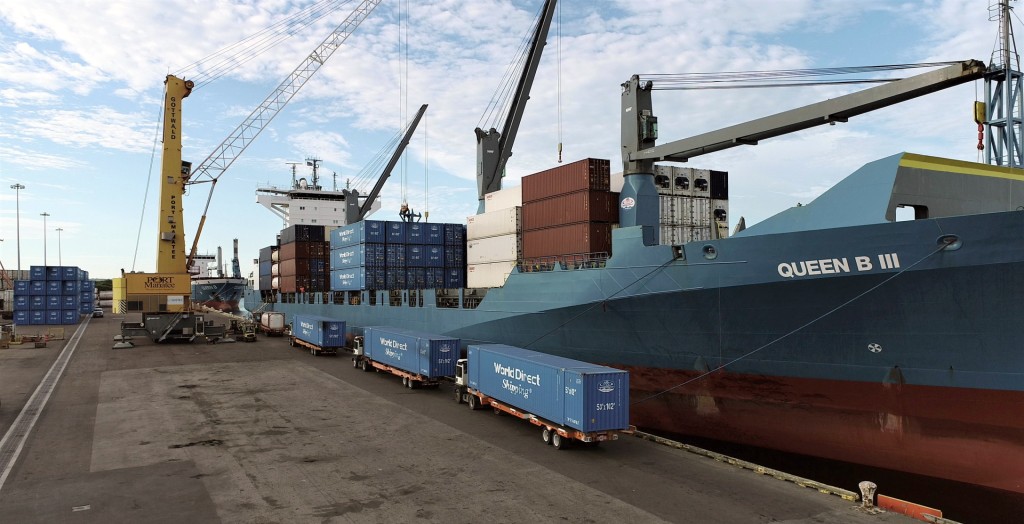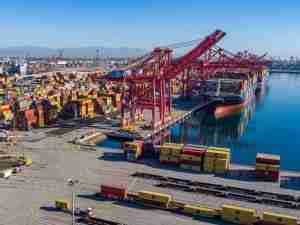Port Manatee container trade skyrockets 53.3 percent in record fiscal 2021
Port Manatee’s skyrocketing containerized cargo trade continues to rise to record heights – soaring more than 53 percent in the just-ended fiscal year – while total cargo tonnage moving through the seaport has also reached an all-time high, according to figures reported today [Tuesday, Oct. 19].
In its fiscal year ended Sept. 30, a record 135,660 twenty-foot-equivalent container units crossed the docks of Central and Southwest Florida’s preferred gateway for global commerce, up 53.3 percent from moves of 88,466 TEUs in the preceding 12-month period. The fiscal 2021 figure is more than 3 1/2 times the 38,361 TEUs handled by Port Manatee just three years earlier, in fiscal 2018.

Port Manatee also achieved a record in total cargo tonnage in fiscal 2021, with 10,451,566 short tons handled, up 12.1 percent from 9,327,043 tons in fiscal 2020 and eclipsing the prior pinnacle of 10,081,743 tons handled in fiscal 2019.
“The pandemic has by no means slowed the safe, efficient flow of cargo through Port Manatee as we proficiently meet demands of consumers for everything from fresh produce to forest products,” said Carlos Buqueras, executive director of Manatee County’s dynamic seaport. “And, with completion of our expanded dockside container yard and additional infrastructure enhancements on the horizon, Port Manatee is ideally positioned to sustain its cargo volume surge.”
The soon-to-be-completed expansion is more than doubling the size of the paved facility adjoining Port Manatee’s Berth 12 and 14 docks, bringing the yard’s extent to 21.9 acres.
Propelling the past year’s rise in Port Manatee container volume are a pair of carriers – World Direct Shipping and Del Monte Fresh Produce N.A. Inc. WDS, based at Port Manatee, has added a third company-owned vessel and a fleet of 53-foot-long ocean containers to its expanding services offering the fastest short-sea link between Mexico and the U.S. Southeast since 2014. Meanwhile, the Del Monte unit, bringing Latin American fruit to its Southeast distribution center at the port since 1989, has completed its shift to new-generation, energy-efficient containerships.
Measured in short tons, Port Manatee’s fiscal 2021 container trade also hit a high mark, reaching 1,012,376 tons, up 51.4 percent from 668,672 tons in fiscal 2020.
Forest product tonnage moving through Port Manatee in fiscal 2021 was more than 2.3 times that of the preceding 12-month period, rising to 331,024 tons from 142,312 tons a year earlier. The volume of wood pulp – including that used in manufacture of much-in-demand toilet paper – reached 138,950 tons, more than four times the fiscal 2020 volume of 26,373 tons, while tonnage of plywood and particle board more than tripled, to 63,038 tons from 15,366 tons. Lumber volume rose 28.3 percent, to 129,036 tons from 100,573 tons.
The flow of petroleum products through Port Manatee remained strong as well, with the 9,376,621 barrels (393,818,082 gallons) moving through the seaport in fiscal 2021 down just 0.7 percent from 9,441,488 barrels (396,542,454 gallons) a year earlier.
“Port Manatee is continuing its extraordinary course of record activity while fulfilling the needs of our region and beyond,” said Reggie Bellamy, chairman of the Manatee County Port Authority. “At the same time, we and our industry partners are augmenting our significant contributions to economic prosperity.”
Located “Where Tampa Bay Meets the Gulf of Mexico,” Port Manatee is the closest U.S. deepwater seaport to the expanded Panama Canal, with 10 40-foot-draft berths serving container, bulk, breakbulk, heavylift, project and general cargo customers. The self-sustaining port generates more than $3.9 billion in annual economic impacts while providing for more than 27,000 direct and indirect jobs, all without benefit of local property tax support.









